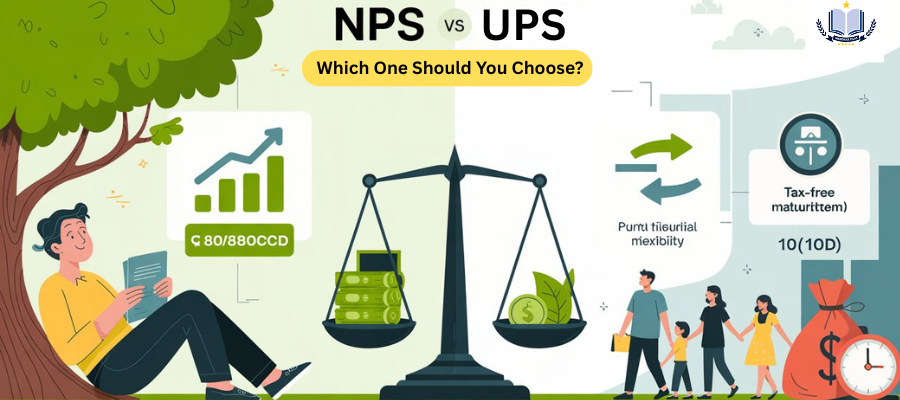Table of Contents
ToggleNPS vs UPS: Which One Should You Choose?
When planning your retirement or backup financial security, two schemes often come into the spotlight – the National Pension System (NPS) and the Uninterruptible Power Supply (UPS) system of employment, often referred to as the Old Pension Scheme (OPS) in government job sectors. While both play crucial roles in providing future security, their purpose and benefits are entirely different. This comprehensive comparison aims to settle the debate: NPS vs UPS: Which One Should You Choose?

Understanding NPS and UPS
What is NPS (National Pension System)?
The National Pension System (NPS) is a government-sponsored retirement savings scheme designed to encourage people to invest in a pension account at regular intervals during their working life. After retirement, subscribers can withdraw a part of the corpus in a lump sum and use the remaining amount to buy an annuity for a regular income.
Regulated by: PFRDA (Pension Fund Regulatory and Development Authority)
Eligibility: Any Indian citizen aged between 18 and 70
Contribution: Voluntary
Returns: Market-linked (Equity, Corporate Bonds, Government Securities)
Tax Benefits: Under Section 80C and 80CCD
What is UPS (Uninterruptible Pension Scheme or Old Pension Scheme)?
UPS, commonly referring to the Old Pension Scheme (OPS), was a defined benefit plan where government employees received a fixed monthly pension based on their last drawn salary. It requires no contribution from the employee and is entirely funded by the government.
Regulated by: Government of India (pre-2004 recruits)
Eligibility: Government employees (selected categories, usually pre-2004)
Contribution: None from employee
Returns: Fixed monthly pension (50% of last drawn salary)
Taxation: Fully taxable
Now, let’s dive deeper into NPS vs UPS: Which One Should You Choose?
NPS vs UPS: A Comparative Analysis
| Criteria | NPS | UPS (Old Pension Scheme) |
|---|---|---|
| Contribution | Employee & employer contribution | No contribution by employee |
| Risk | Market-linked returns | No risk, fixed pension |
| Flexibility | High (choice of fund managers, withdrawal options) | None |
| Return Potential | Can be higher over long term | Fixed, based on last salary |
| Portability | Portable across jobs and locations | Not portable |
| Tax Benefits | Yes (Section 80C, 80CCD) | No specific tax benefits |
| Pension Amount | Depends on corpus & annuity option | 50% of last drawn salary |
| Burden on Govt. | Low | High |
When analyzing NPS vs UPS: Which One Should You Choose, it is evident that NPS is a self-driven investment model, suitable for individuals in private or government jobs after 2004. UPS, on the other hand, provides assured income but is largely unsustainable for the government due to rising fiscal burden.
NPS vs UPS: Which One Should You Choose Based on Your Profile?
For Government Employees (Post-2004)
You are automatically enrolled in the NPS. But with several states pushing for the revival of the Old Pension Scheme, the question arises: NPS vs UPS: Which One Should You Choose?
Choose NPS if you are open to market-linked returns and wish to build a flexible retirement corpus.
Prefer UPS if you want guaranteed monthly pension without worrying about market fluctuations (only possible if your state government reintroduces it).
For Private Sector Employees
The Old Pension Scheme (UPS) is not available to private sector employees. Therefore, in the battle of NPS vs UPS: Which One Should You Choose, the answer is straightforward – NPS is your only option.
For Risk-Averse Individuals
UPS wins due to its fixed and predictable nature. NPS may be intimidating due to equity exposure but offers greater long-term growth.
Advantages and Disadvantages
Advantages of NPS
Tax saving under 80C & 80CCD(1B)
Higher return potential
Transparent and portable
Can continue even after retirement
Disadvantages of NPS
Returns are not guaranteed
Mandatory annuity purchase reduces flexibility
Advantages of UPS
Fixed pension provides peace of mind
No employee contribution required
Disadvantages of UPS
No control over funds
Not sustainable for future generations
Not available to most employees now
FAQs: NPS vs UPS: Which One Should You Choose
Q1. Can I choose between NPS and UPS as a government employee?
It depends on your date of joining. Government employees who joined before January 1, 2004, are under UPS. Those who joined after that are generally under NPS unless their state has opted for UPS revival.
Q2. Which is better for retirement – NPS or UPS?
If you want fixed income and no investment risk, UPS is better. If you prefer higher long-term returns and flexibility, NPS is ideal.
Q3. Is NPS available for private sector employees?
Yes, any Indian citizen between 18–70 years can open an NPS account, including private sector employees.
Q4. Can NPS give more returns than UPS?
Potentially, yes. Since NPS is market-linked, it can deliver higher returns over a long period, but it also carries some risks.
Q5. Why is UPS considered financially unsustainable?
Because UPS is funded entirely by the government and guarantees fixed pensions, it increases the fiscal burden and lacks long-term sustainability.
Q6. How is the pension calculated in UPS?
Under UPS, the pension is generally 50% of the last drawn basic salary, with possible dearness relief as applicable.
NPS vs UPS: Which One Should You Choose – Final Thoughts
So, NPS vs UPS: Which One Should You Choose? The answer depends on your employment type, risk appetite, and long-term retirement goals. For private sector employees and post-2004 government recruits, NPS is the only available and sustainable choice. However, if you are a government employee in a state where UPS has been revived, you might prefer the Old Pension Scheme for its certainty.
With increasing financial awareness, most new investors now lean towards NPS for its transparency, returns, and flexibility. Yet, the debate around NPS vs UPS: Which One Should You Choose continues to dominate policy and public forums.

